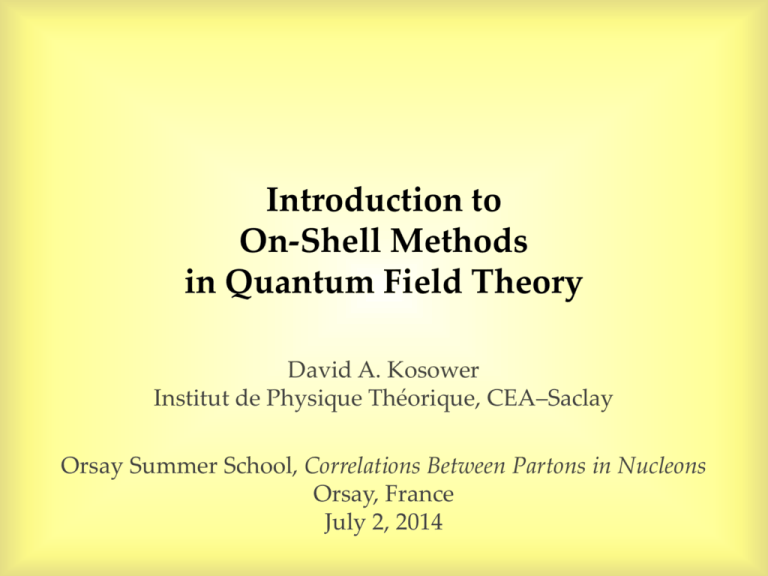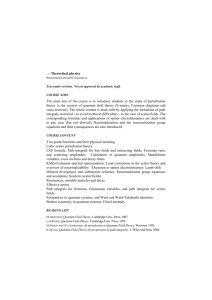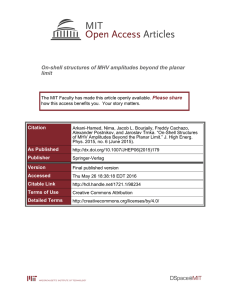spinor products
advertisement

Introduction to On-Shell Methods in Quantum Field Theory David A. Kosower Institut de Physique Théorique, CEA–Saclay Orsay Summer School, Correlations Between Partons in Nucleons Orsay, France July 2, 2014 Tools for Computing Amplitudes • New tools for computing in gauge theories — the core of the Standard Model • Motivations and connections – Particle physics: SU(3) SU(2) U(1) – N = 4 supersymmetric gauge theories and strong coupling (AdS/CFT) – Witten’s twistor string – Grassmanians – N = 8 supergravity Amplitudes • Scattering matrix elements: basic quantities in field theory • Basic building blocks for computing scattering cross sections • Using crossing MHV • Primary interest: in gauge theories; can derive all other physical quantities (e.g. anomalous dimensions) from them • In gravity, they are the only physical observables Traditional Approach • Feynman Diagrams – – – – – Widely used for over 60 years Heuristic pictures Introduces idea of virtual or unphysical intermediate states Precise rules for calculating amplitudes Classic successes: electron g-2 to 1 part in 1010; discovery of asymptotic freedom • How it works – – – – Pick a process Grab a graduate student Lock him or her in a room Provide a copy of the relevant Feynman rules, or at least of Peskin & Schroeder’s Quantum Field Theory book – Supply caffeine, a modicum of nourishment, and occasional instructions – Provide a computer, a copy of Mathematica, a copy of FORM & a C++ compiler A Difficulty • Huge number of diagrams in calculations of interest — factorial growth with number of legs or loops • 2 → 6 jets: 34300 tree diagrams, ~ 2.5 ∙ 107 terms ~2.9 ∙ 106 1-loop diagrams, ~ 1.9 ∙ 1010 terms • In gravity, it’s even worse Results Are Simple! • Parke–Taylor formula for AMHV Parke & Taylor; Mangano, Parke, & Xu Even Simpler in N=4 Supersymmetric Theory • Nair–Parke–Taylor formula for MHV-class amplitudes Answers Are Simple At Loop Level Too One-loop in N = 4: • All-n QCD amplitudes for MHV configuration on a few Phys Rev D pages On-Shell Methods • All physical quantities computed – – – – From basic interaction amplitude: 𝐴tree 3 Using only information from physical on-shell states Avoid size explosion of intermediate terms due to unphysical states Without need for a Lagrangian • Properties of amplitudes become tools for calculating – Kinematics Spinor variables – Underlying field theory Integral basis – Factorization On-shell recursion relations (BCFW) for tree-level amplitudes Control infrared divergences in real-emission contributions to higher- order calculations – Unitarity Unitarity and generalized unitarity for loop calculations We can now calculate large classes of amplitudes in gauge theories Gauge Theoryto infinite numbers of legs Sometimes Amplitudes A wealth of data for further study A foundation for a new subfield Integrability String Theory Spinor Variables From Lorentz vectors to bi-spinors 2×2 complex matrices with det = 1 Spinor Products Spinor variables Introduce spinor products Explicit representation where Properties of the Spinor Product • Antisymmetry • Gordon identity • Charge conjugation • Fierz identity • Projector representation • Schouten identity Spinor Helicity Gauge bosons also have only ± physical polarizations Elegant — and covariant — generalization of circular polarization ‘Chinese Magic’ Xu, Zhang, Chang (1984) reference momentum q Transverse Normalized Color Decomposition With spinors in hand, we can write a color decomposition formula Integral Basis • At one loop – Tensor reductions Brown–Feynman, Passarino–Veltman – Gram determinant identities – Boxes, triangles, bubbles, tadpoles • At higher loops – – – – Tensor reductions & Gram determinant identities Irreducible numerators: Integration by parts Chetyrkin–Tkachov Laporta algorithm AIR (Anastasiou,Lazopoulos), FIRE (Smirnov,Smirnov), Reduze (Manteuffel, Studerus), LiteRed (Lee) – `Four-dimensional basis’: integrals with up to 4 L propagators BCFW On-Shell Recursion Relations Britto, Cachazo, Feng, Witten (2005) • Define a shift of spinors by a complex parameter z • which induces a shift of the external momenta and defines a z-dependent continuation of the amplitude A(z) • Assume that as • Momenta are still on shell • Momentum is still conserved A Contour Integral Consider the contour integral Determine A(0) in terms of other residues Using Factorization Other poles in z come from zeros of z-shifted propagator denominators Splits diagram into two parts with z-dependent momentum flow Exactly factorization limit of z-dependent amplitude poles from zeros of That is, a pole at Residue Notation 𝑘 = 𝑘(𝑧𝑎𝑏 ) On-Shell Recursion Relation = • Partition P: two or more cyclicly-consecutive momenta containing j, such that complementary set contains l, On shell • The recursion relations are then Unitarity • Basic property of any quantum field theory: conservation of probability. In terms of the scattering matrix, In terms of the transfer matrix or with the Feynman i we get, Diagrammatically, cut into two parts using Cutkosky rule Gedanken calculation Some diagrams are missing one or both propagators surrounding K2: no contribution Also fate of “off-shell” terms Basic Unitarity • Can reverse this approach to reconstruct amplitude from its discontinuities • Look at all channels • At one loop, each discontinuity comes from putting two propagators on shell, that is looking for all contributions with two specified propagators Unitarity Method Formalism Rational function of spinors Known integral basis: On-shell Recursion; Unitarity in D = 4 D-dimensional unitarity via ∫ mass Generalized Unitarity • Unitarity picks out contributions with two specified propagators • Can we pick out contributions with more than two specified propagators? • Yes — cut more lines • Isolates smaller set of integrals: only integrals with propagators corresponding to cuts will show up • Triple cut — no bubbles, one triangle, smaller set of boxes • Can we isolate a single integral? • D = 4 loop momentum has four components • Cut four specified propagators (quadruple cut) would isolate a single box Quadruple Cuts Work in D=4 for the algebra Four degrees of freedom & four delta functions … but are there any solutions? A Subtlety The delta functions instruct us to solve 1 quadratic, 3 linear equations 2 solutions If k1 and k4 are massless, we can write down the solutions explicitly solves eqs 1,2,4; Impose 3rd to find or • Solutions are complex • The delta functions would actually give zero! Need to reinterpret delta functions as contour integrals around a global pole [other contexts: Vergu; Roiban, Spradlin, Volovich; Mason & Skinner] Reinterpret cutting as contour modification • Global poles: simultaneous on-shell solutions of all propagators & perhaps additional equations • Multivariate complex contour integration: in general, contours are tori • For one-loop box, contours are T4 encircling global poles Two Problems • Too many contours (2) for one integral: how should we choose the contour we use? • Changing the contour can break equations: is no longer true if we modify the real contour to circle only one of the poles Remarkably, these two problems cancel each other out • Require vanishing Feynman integrals to continue vanishing on cuts • General contour 𝑎1 = 𝑎2 Box Coefficient Go back to master equation A B D C Apply quadruple cuts to both sides Solve: Britto, Cachazo, Feng No algebraic reductions needed: suitable for pure numerics Planar Double Box • Take a heptacut — freeze seven of eight degrees of freedom • One remaining integration variable z • Six solutions, for example S2: • Performing the contour integrals enforcing the heptacut Jacobian • Localizes z global pole need contour for z within Si • But: Solutions intersect at 6 poles 6 other poles are redundant by Cauchy theorem (∑ residues = 0) • Overall, we are left with 8 global poles (massive legs: none; 1; 1 & 3; 1 & 4) • Connections to algebraic geometry • Two master integrals • 4 ε constraint equations • 2 IBP constraint equations Two master contours – one for each integral • Master formulæ for coefficients of basis integrals to O (ε0) where P1,2 are linear combinations of T8s around global poles More explicitly, Summary • Natural variables for kinematics: spinors • Factorization can be exploited to obtain on-shell recursion relations • Unitarity can be generalized to analytic structure, and exploited to compute loop amplitudes Beyond the basics: • Differential equation and symbol techniques for higherloop integrals







